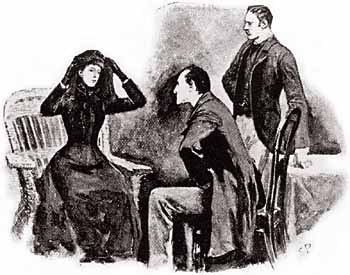
Amber, 12, and I have been reading some of the Sherlock Holmes short stories lately. The first we read is to me one of his most memorable, “The Adventure of the Speckled Band.”
Amber of course knows who Sherlock Holmes is, and I guess she’s watched a couple episodes of the BBC series at her friend’s house, but this is the first time she’s actually read/heard any of the original stories. I have to admit that it was fun to introduce her to one of my favorite characters.
On glancing over my notes of the seventy odd cases in which I have during the last eight years studied the methods of my friend Sherlock Holmes, I find many tragic, some comic, a large number merely strange, but none commonplace; for, working as he did rather for the love of his art than for the acquirement of wealth, he refused to associate himself with any investigation which did not tend towards the unusual, and even the fantastic. (First line, “The Adventure of the Speckled Band”)
Helen Stoner is a scared, grief-stricken woman who turns to Sherlock Holmes for help. Her sister died a violent death just as her wedding day approached. Helen herself is now engaged and fearful that she will meet a similar fate. Helen doesn’t have very many clues to give the detective. For one, her sister Julia was set to receive an inheritance upon her marriage. This money, which would have come from their late mother’s estate, was to have been divided between the two sisters and their stepfather, a moody and distant man. Strangely, Julia was able to speak only a few cryptic words—about a “speckled band”—before she collapsed, gasping for breath, in Helen’s bedroom. The only speckled bands that come to Helen’s mind are the dotted headbands worn by gypsies, whom she fears strangled her sister. Now that Helen is staying alone at her stepfather’s home, she is afraid for her life. Strange sights and sounds around the house terrify her even further and it seems that time is running out as the perpetrator remains at large. Holmes is determined to protect this vulnerable young woman.
The bad guy is pretty obvious from the get go. It’s how the murder was accomplished that drives the story. It’s essentially a locked room mystery. No one could have gotten in or out to kill the young woman. Holmes puts all the clues together and comes up with the only possible solution, which is of course, proved true.
We read this in The Baker Street Dozen edited by P. J. Doyle and E. W. McDiarmid, which states that it was one of Doyle’s favorites. And it is so unusual, such a unique method of killing that I can totally understand why. In real life, it might not have been possible for a number of reasons, but it’s just perfect in fiction. I do think this is one of the few stories where Holmes so directly kills someone. It’s been a while since I’ve read most of them though, so I may be wrong.
I am so happy to be re-reading these classic short stories. And I think that Holmes methods work well for short stories. There’s not much character development of the secondary characters, but that doesn’t bother me. The clues are unbelievable, but in true style, Holmes explains it all in the end. The set up works well for Amber too. She sees all the clues that Doyle lets us, but is totally perplexed. Just when she gets ready to say “I don’t get it” Holmes goes into his explanation. And each story is short enough to read in two nights or so.
4 out of 5 stars
Category: Mystery
Sherlock Holmes
First published February 1892
10,440 words
March Mystery Madness is hosted by Christina at Reading Thru the Night.
Book source: Personal library
Having just read and reviewed my first ever Sherlock Holmes book (It was by Anthony Horowitz and not Conan Doyle) I’m keen to read some more – perhaps this is where I’ll begin.
I have yet to read any Sherlock Holmes, but your review reminds me that I should. It is nice that you can share the stories with Amber.
And I have not read a single book about him
Love this story